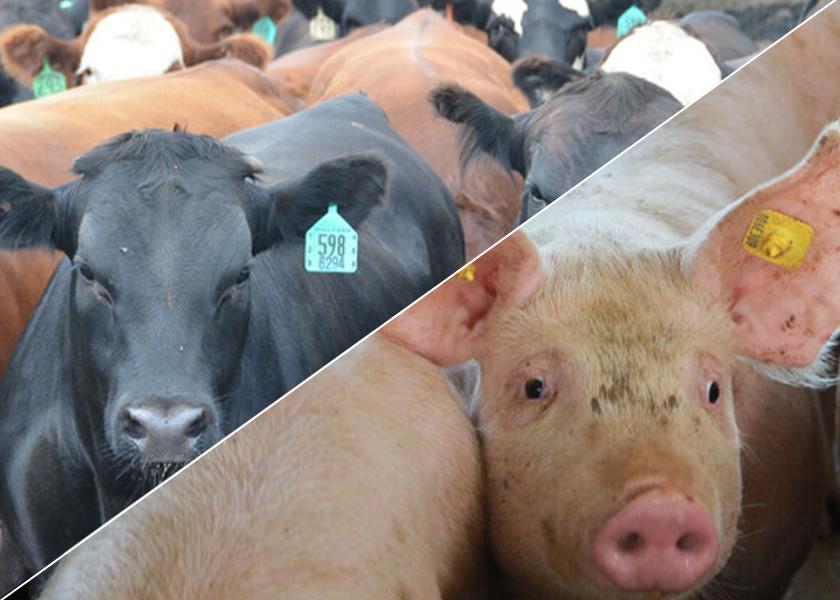Livestock Analysis | November 28, 2022

Price action: February lean hogs fell $3.75 to $84.75, the contract’s lowest close since Oct. 14.
Fundamental analysis: Hog futures fell sharply as protests in China over Covid lockdowns unnerved global markets and stirred concern over the country’s demand for agricultural products, such as pork. China is a top buyer of U.S. pork, though its imports this year through September were down 59% from the same period in 2021. Still, Rabobank expects China’s pork imports to build through the fourth quarter and rise next year as domestic pork prices are surging and hog numbers are lower than Beijing has indicated. A stronger dollar today also weighed on livestock futures.
Cash hog fundamentals continued to slip. The CME lean hog index fell 61 cents to $85.56 (as of Nov. 23), the lowest price level since February. December futures’ discount to the index widened to $4.96 at today’s close from as low as $1.61 Nov. 23, indicating traders expect the index to continue its seasonal decline into the contract’s mid-December expiration. The five-day rolling average national direct cash hog price today was quoted at $81.99. Pork cutout values rose $9.80 early today to $97.43, driven by a gain of nearly $37 in bellies.
Technical analysis: Hog bulls have lost the near-term technical advantage as the market took a substantially bearish turn with the sharp declines in recent days. The next downside objective for bears is closing February futures below solid support at $82.00. For bulls, the next objective is to close February futures above solid resistance at $90.00. First resistance is seen at $86.00, then $87.00. First support is seen at today’s low of $84.575, then $83.00.
What to do: Get current with advised feed coverage. Be prepared to extend coverage on additional price pressure.
Hedgers: Carry all risk in the cash market for now.
Feed needs: You have 100% of soybean meal and corn-for-feed needs covered in the cash market through November.
Price action: February live cattle fell 45 cents to $154.675, the contract’s lowest close since Nov. 16, while January feeder cattle fell $1.425 to $176.875, the lowest close since Oct. 14.
Fundamental analysis: Live cattle futures fell a fourth consecutive session and ended near a two-week low as eroding technicals and concerns over global demand overshadowed recent cash market strength. Concern over widespread protests in China regardinger the country’s Covid lockdowns rattled global markets today and contributed to pressure on many commodities. Cash cattle prices rose sharply last week as packers were apparently short-bought on needs for this week’s full slaughter schedule. Live steers averaged $156.07 last week, up $3.19 from the previous week’s average and the eighth straight weekly increase. With another big slaughter likely next week, packers are expected to actively pursue cattle again this week, though fresh contracted supplies for December could temper their demand in the negotiated market.
Wholesale beef prices have been under pressure for much of the past month, indicating packers are cutting prices to move product, but rebounded today. Choice beef cutout values early today rose $3.00 to $254.83, up from a five-week low posted Friday.
Technical analysis: Live cattle technicals eroded sharply over the past week, with February futures holding a neutral-to-bearish near-term bias and strong potential for further downside in coming sessions. February live cattle closed on the 20-day moving average, currently around $154.85, for the first time since Nov. 16. A drop under today’s low at $154.125, which is slightly under the 40-day moving average, may have bears targeting the 50- and 100-day moving averages, which converge around $153.85 to $153.75. Key support is seen at $153.00 and the November intraday low of $152.275. Upside levels to watch in February live cattle include last week’s high of $156.95.
What to do: Get current with advised feed coverage. Be prepared to extend coverage on additional price pressure.
Hedgers: Carry all risk in the cash market for now.
Feed needs: You have 100% of soybean meal and corn-for-feed needs covered in the cash market through November.






